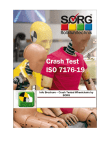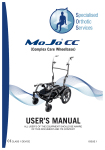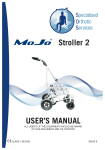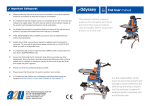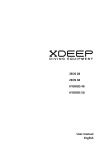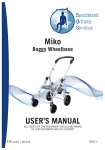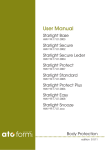Download User Guide - Activate For Kids
Transcript
User Guide Issued 1st October 2007 CONTENTS Page Content 1 Introduction 2 Safety Notes 3 Opening/folding frame, Brakes. 4 Tilting Seat, Footrest, Seat Depth 5 Hip Guides, Lateral Support 6 Headrest, Harness, Seat Attachment 7 Castors, Handle Height, Rear Wheels 8 Hood, Footmuff 9 Using the Stroller 10 Transportation 11 Transportation 12 Transportation 13 Care and Maintenance 14 Service Record Welcome to the Phoenix Buggy User Guide The Phoenix Buggy has been designed to provide a robust, transportable mobility solution for children from 6 month to 4 years. The seating system gives good support from a very early age, but is very light, making the parents lives easier. The seat removes and the stroller base also folds for storage or stowage, improving your convenience. The appearance is designed to look as normal as possible on the high street. It is, in fact, based on a high street stroller. Please read this User Guide before using your Phoenix Buggy for the first time. If you have any further questions after you have read the User Guide, please contact your dealer. Retain the User Guide for future reference and for other stroller users. 1 SAFETY NOTES Please read this user guide fully before using your stroller. Expert medical advice must be sought before using your stroller. If you have any doubt about this speak to your Occupational Therapist. Before using the stroller it is essential to check that the Frame Catch is locked, and that the Tilt-inspace mechanism is tightened. Each attendant should be familiar with the operation of the stroller. If there is any doubt they should read this User Guide. Before setting off, ensure that the occupant is comfortable, and that clothes and rugs are tucked in, so that they do not catch on the wheels. Always apply the parking brake when the stroller is stationary and when getting in and out of the stroller. Never tip the stroller forward when going down a kerb. If the stroller is going to be used for transport in a vehicle you should carefully read the Transport Section of this User Guide. The attendant must take precautions against fire risk. In buildings, check the locations of fire exits and make sure the emergency procedures are understood. Do not let children play with, or hang on the stroller. Do not use your stroller in a manner for which it is not designed. Ensure that children are clear of moving parts before making adjustments. Patron Bohemia, Activate, and your dealer, cannot accept responsibility for the use of accessories other than those supplied by them. Full concentration must be maintained during travel to avoid collisions or other dangerous situations. Make sure that the stroller brakes are applied while adjusting the tilt of the seat. This will leave both hands free to operate these features, avoiding sudden movements which will cause discomfort to the occupant. The seat base attachment must not be released while the stroller is occupied. Make sure that the seat is empty before removing the seat or changing its direction of travel. Do not overload the stroller. Other children should not ride on the back of the stroller, or loads attached to the frame other than on the approved accessories. Ensure that the occupant has the appropriate harness attached and adjusted to prevent them from falling out of the stroller while travelling. The attendant should know how to fit, adjust, and release these features. Do not stand on the footrest Never leave the child unattended in the stroller, even for the shortest time. At all times when operating the stroller, be aware of the danger of injury to yourself, the occupant or any other person, especially when going through doorways. Patron Bohemia, Activate, and your dealer, cannot accept responsibility for any loss, damage or injury resulting from the incorrect operation of your stroller. 2 OPERATING INSTRUCTIONS UNFOLDING THE STROLLER Place the stroller on its wheels. Stand behind the rear wheels and pull the handle up towards you. Unfold the frame fully until the frame catch is locked and the safety catch is in place. FOLDING THE STROLLER – see also Page 14 Set the Seat position as upright as possible, then remove the seat to fold the Frame. Release the safety catch, and pull the frame catches upwards until they are clear of the lower frame. One of the catches should be rotated to release the safety lock. The handle can then be folded downwards, allowing the frame to collapse. There is a strap provided to keep frame closed for easy handling. Take care to avoid trapping fingers! Always keep a firm grip on the stroller while folding or unfolding. OPERATING THE PARKING BRAKE To put the brake on, push down the brake lever with your foot, and the spring mechanism will hold the brake onto the wheel. To release, lift the bar with your foot, until it returns to the stroller frame. Brake off Brake on. 3 SEAT UNIT TILT ADJUSTMENT Hold the backrest firmly. Squeeze the two handles together to disengage the tilt lock and reset to the desired angle. Check that the pins have located into the new setting before releasing the backrest. FOOTREST HEIGHT ADJUSTMENT Loosen the bolts that secure the footrest to the footrest hanger, and set to the desired height. Re-tighten the bolts to secure this position. To attach the footrest, the pop-pin must be pulled out as the footrest hanger is placed into the bracket under the seat. The pop-pin will click into positon to secure the footrest SEAT DEPTH ADJUSTMENT To adjust the seat depth, the bolts that attach the seat base plate to the seat brackets should be loosened as shown – there are four altogether. The seat depth should then be reset and the bolts all re-tightened. REMEMBER: When making adjustments, do not remove nut completely. Just loosen off about one full turn. Tighten each nut in turn when adjustment is complete. 4 HIP GUIDE ADJUSTMENT To adjust the hip guides for width the bolts beneath the seat should be loosened as shown. Set to the desired width position, and retighten. * For particularly small sizes, the Hip Guide Plate can be fitted on top of the seat plate. To adjust the Hip Guide backwards or forwards, loosen the bolts inside the hip guide pad cover and move to the desired position. Retighten the bolts. LATERAL SUPPORT ADJUSTMENT The lateral supports are adjusted by loosening the bolts as shown. This gives width and height adjustment. Retighten the bolts when the desired position is obtained. The Lateral supports swing away for easy access. Push with your finger to lift the ball knob. 5 ATTACHING THE HEADREST The Headrest is attached by Velcro straps around the backrest. This can be set at various heights. FITTING THE HARNESSES The shoulder straps are passed through the appropriate reinforced position in the backrest. The straps feed through the backrest and are secured within the enclosed panel on the back of the backrest. The webbing should be passed through the cam buckle and the cam buckle closed firmly on it in the correct position for the occupant. The lower straps are attached to the seat bracket using the triglide provided. Harnesses will be supplied with appropriate instructions. REMOVING AND ATTACHING THE SEAT To attach the seat the front bar of the seat unit is positioned into the front channel. The seat is then rotated backwards so that the back bar fits into the channel at the rear of the seat carriage. The Pop-Pin then secures the seat in position. The seat can be fitted either forward facing or rearward facing, whichever suits the child and attendant. 6 LOCKING THE CASTORS The castors are able to be locked into position to assist when travelling over rough ground. He poppin is lifted and turned to release it from the unlocked position, and the pin then locates into the castor when it is in-line with the direction of travel. ADJUSTING THE HEIGHT OF THE HANDLE The height of the handle is adjusted by pressing the buttons on the adjustment knuckles as shown. REMOVING THE REAR WHEELS The rear wheels are quick release making storage easier. The clips are pushed in to release the wheel. When refitting, check that the wheel clip is located. ADJUSTING THE SUSPENSION The suspension has two settings. The firmer setting should be used for occupants over 10kg to ensure that the ride has the correct cushioning effect. The Suspension setting is changed by moving the lever as shown. 7 FITTING THE HOOD The hood is attached as shown, with the hood connectors fitted into the hood brackets on the sides of the backrest. To release, press in the triangular catch and slide the hood forward. FITTING THE FOOTMUFF The Footmuff is attached to the hood as shown. There is an alternative position to pin the footmuff, about 100ml above the seat level. TO LOAD INTO A CARBOOT Remove the footrest. Remove the seat from the chassis. The seat will now sit firmly on the two tubes underneath. Fold and load the chassis separately. 8 Using your stroller…… GETTING INTO THE STROLLER Make sure that the parking brake is on. Either ask another helper to steady the stroller by holding the handle, or place the handle up against a wall to minimise the risk of tipping. Place the child in the stroller and fasten the harnesses. The child should always feel comfortable and secure in the stroller. GETTING OUT OF THE STROLLER Make sure that the parking brake is on. Reverse the procedure for getting into the stroller. NEGOTIATING A KERB OR SINGLE STEP To go down a kerb, approach the kerb until the front castors are near the edge. Grip the handle firmly and tip the stroller backwards to balance on the rear wheels. Lower the castors over the kerb on the rear wheels, returning the front castors to the ground when you have reached the lower level. To go up a kerb, reverse the procedure. Do not approach the kerb with the front castors. This may seem easier, but puts more strain on the stroller and also on you. Never tip a stroller forwards at a kerb. Always make use of ramps and lifts if they are available. Do not attempt to mount a flight of stairs or steps. 9 OCCUPIED TRANSPORT OF A PHOENIX BUGGY IN A SUITABLY MODIFIED VEHICLE SECURING THE BUGGY TO THE TRACK SYSTEM IN THE VEHICLE FLOOR The Phoenix Buggy must be secured to the vehicle floor using a 4-point webbing restraint system. We prefer the tongue and buckle style connection as it will not cause scratching to the stroller frame. THE STROLLER MUST BE IN A FORWARD FACING POSITION. Wheel the stroller into position and apply the brakes. The front of the stroller is secured first. Attach the front restraints to the track system making sure that they are locked in position. Pass the webbing around the tie-down point, which is clearly marked on the stroller chassis. Always attach around the v-shaped section of the frame – the strongest part of the construction. Now that the front of the stroller has been secured, carefully move the stroller backwards to take up the slack in the front restraints, and re-apply the brakes. The rear restraints are attached to the upright section of the stroller frame at the clearly marked attachment point. When the restraint is also attached to the track system in the vehicle floor, use the ratchet to pull the restraint tight. Make sure that you have tensioned the restraint on both sides of the stroller, and check that the stroller feels secure. THE RESTRAINTS SHOULD BE ATTACHED AT AN ANGLE OF NO MORE THAN 45 DEGREES TO THE VEHICLE FLOOR. IF YOU ARE IN ANY DOUBT, CONTACT THE RESTRAINT MANUFACTURER FOR SPECIFIC INSTRUCTION RELATING TO THEIR SYSTEM, OR YOUR DEALER FOR QUERIES RELATING TO THE STROLLER. You have not finished yet! 10 SECURING THE PASSENGER RESTRAINT AROUND THE OCCUPANT AND ATTACHING TO THE TRACK SYSTEM IN THE VEHICLE FLOOR. The following points relate to the safety of the occupant: Check that occupant weighs no more than 35kg. Make sure that the seat base is at 90 degrees to the seat back. The seat back should be as upright as possible. No additional seating cushions should be used in transportation. 1) The stroller occupant is protected by a 3-point passenger restraint, described by the restraint manufacturer as a SPLIT REEL DOUBLE INERTIA. The double inertia reel is attached to the track system on the track closest to the vehicle wall on which the upper torso anchorage is mounted. The stalk with the buckle on is placed opposite the double inertia reel on the other track. These should be positioned about 350mm/14” behind the stroller backrest to ensure a steep angle of application of the lap belt. The lap belt is reeled out from the front of the double inertia reel, fed between the stroller seat side and the backrest in order to maintain a steep angle over the pelvis. The belt must fit snugly over the pelvis and between the seat side and the backrest on the other side of the seat unit. The clip then attaches to the stalk, which is fixed to the track in the vehicle floor. The lap belt should be adjusted to be close fitting to avoid abdominal intrusion on impact. The upper torso restraint is reeled out of the rear of the double inertia unit. The leading clip is passed over the occupant’s shoulder, and attached to the buckle on the lap belt. This will be found just above the lap belt attachment to the stalk. The remaining clip is then attached to the restraint anchorage on the vehicle wall. This should be adjusted to be at, or just above, shoulder level. The upper torso restraint should be adjusted to be close fitting, and comfortable for the occupant. 2) Alternatively, the QStraint deluxe retractor system can be used in conjunction with tethers to the backrest and a crashworthy integrated occupant restraint. This uses the occupants postural harnessing to secure the occupant for transport. This method is very quick and easy and minimises the interference with the occupant while securing the buggy into the vehicle. Separate instructions are provided with this system. DETAIL OF RESTRAINT ATTACHMENT 1. View of front tie-downs 2.View of rear tie-downs 11 KEY POINTS RELATING TO TRANSPORTATION 1. The stroller must face forwards in the vehicle – in the direction of travel. 2. The stroller must be restrained with a 4-point tiedown. No other restraint system must be used. 3. The occupant must be restrained by a 3-point passenger restraint. 4. The passenger restraint must be anchored at, or above, shoulder level. 5. The lap section of the passenger restraint should fit snugly over the pelvis of the occupant, at a steep angle of application to avoid abdominal intrusion. 6. Check with the vehicle converter that the vehicle floor and side wall structures have the appropriate strength required by the restraint manufacturers for the installation of the restraint systems. 7. Check that the vehicle converter has fitted the restraint system in conjunction with the restraint manufacturer. All manufacturer’s recommendations and guidance notes should be followed. 8. Check that all vehicle operators are suitably trained in the use, care and maintenance of the restraints. 12 CARE AND MAINTENANCE Your stroller has been designed and produced to a high standard. With correct use and maintenance it will give you many years of trouble-free service. Please read the following instructions. Regularly inspect the frame catch and the attached safety clip, the occupant bar fitting, locking devices, catches, the footrest and all fixings on the frame to ensure that they are secure and in good working order. Brakes, wheels and tyres are subject to wear. If they need to be replaced, the work must be done by a qualified rehabilitation engineer. We recommend that the stroller is checked once a year by a qualified rehabilitation engineer. Any damage or repairs should be assessed by a qualified rehabilitation engineer, or should be returned to your dealer. Only genuine Patron Bohemia parts should be used when your stroller is repaired. Regular lubrication of moving parts will extend the life of your stroller and will make folding and unfolding easier. Use a spray lubricant and wipe off any excess spray. Any overspray will encourage a build up of dirt. Make sure that you are familiar with the folding method for your stroller. It should always fold easily, so do not force the mechanism if it does not. Stop and read this user guide again. Wheels and other plastic or metal parts may be sponged clean with warm water and a mild detergent. The fabric covers are removable, and should be washed in water no hotter than 40 degrees centigrade. Never clean the stroller with abrasive cleaners, ammonia based, bleach based or spirit based cleaners. After exposure to damp conditions, dry off your stroller with a soft cloth, and leave unfolded in a warm, dry environment. Store your stroller in a dry, safe place. 13 Before folding the Phoenix Buggy, set the seat carriage level. You may always have the seat tilted, but the buggy must not be folded with the seat carriage in this position. Attempting to fold the buggy incorrectly may damage the frame and invalidate the warranty. 14 Service Record Date Details




















